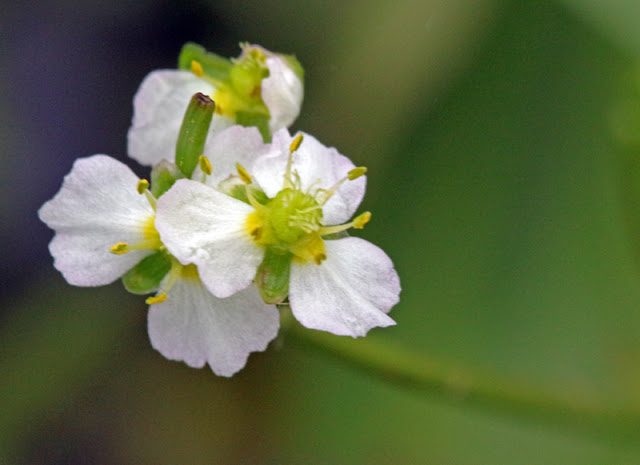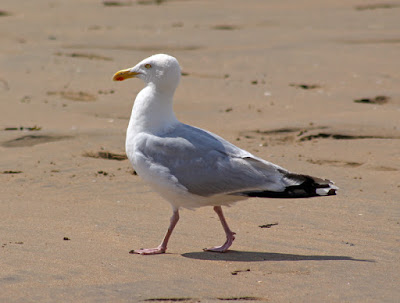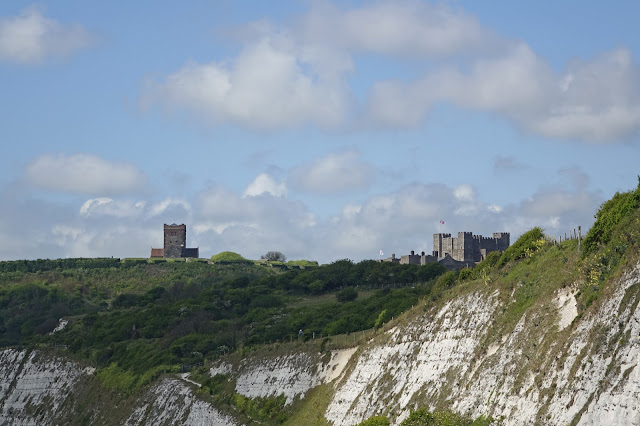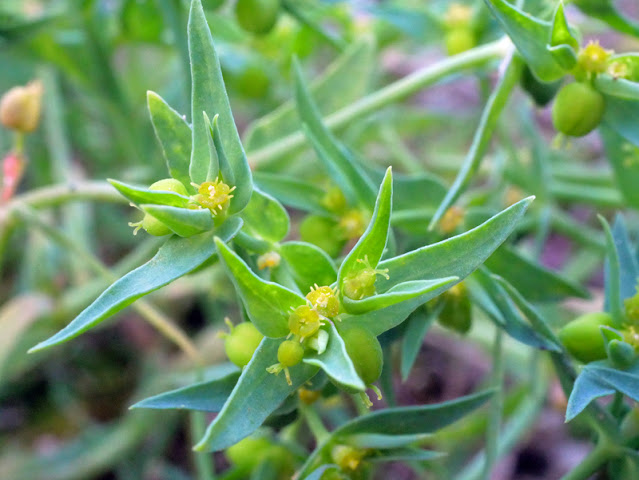Pett Level & Camber, East Sussex - 5th August 2017
This day was overcast with occassional heavy showers, so it was a case of short walks and back to the car quick to dodge a soaking.
I managed a walk of a few hundred metres along the very Western edge of the Royal Military Canal at Pett Level and here is what I photographed. Again, I'll describe them in scientific name alphabetical order.
Alisma plantago-aquatica
The above photos show Water Plantain. It usually grows in shallow water or by the margins of ponds, lakes and streams. It's a tall, spindly plant with big lower leaves and tiny pretty white flowers with a yellow blotch on the centre of each petal.
Below is the familiar fruiting heads of Lesser Burdock, whose seeds stick to clothing with their hooked spines thus transporting them well away from the parent plant. This plant's seeds were the inspiration for the inventor of Velcro and nice fizzy drinks were made from it as well. Other common names from the past include, Hurr-burr, Clouts, Cockle-dock and Sticky Buttons.
You can easily tell Lesser and Greater Burdock apart by gently squeezing a lower stem leaf stalk. If hollow it's Lesser, if solid, it's Greater. Also, with Greater, there tends to only be masses of flowers on the terminal ends of the stalks and not all up the stem. Generally, Greater has much bigger basal leaves as well. Look out for hybrids though!
In areas where the soil was sparse, there were numerous Viper's Bugloss plants with their blue and purple flowers, a beacon for bees and pollinators. Very common on the coast and sometimes inland as well in arable field edges.
Echium vulgare
Next to this were a lot of Blue Fleabane, a beautiful, though compact member of the Daisy family. Having small flowers, most people fail to notice how beautiful they are, take a closer look!
I've covered Hemp Agrimony in recent posts, so will confine myself to a single photo. It loves damp places and the edge of the canal was ideal for it. From afar it looks like a big pink flower atop a large green, leafy plant. Close up, the "flower" comprises of hundreds of tiny florets, amazing!
I was very pleased to find this next plant. It's Yellow Loosestrife, a native damp loving plant. I was pleased because it's becoming harder to find. The usual one found in the wild now is Dotted Loosestrife, a larger plant with bigger yellow flowers and purple colouring inside the flower - and that's a garden escape.
I much prefer this delicate, multi branched native plant.
Common Mallow was ever present, but Musk Mallow (below) always has the better floral displays than its comparitively drab cousin.
I think it's a shame that many common wildflowers never get any "press" so here goes.
This is Mouse-ear Hawkweed, so called as it has mouse ear shaped leaves with long hairs poking up. You can find these leaves all year round in short turf.
The flowers are a delicate lemon yellow and smaller than most Dandelion like plants.
Pilosella officinalis
This common flower is called Silverweed, so called as its leaves are a grey silvery green, another plant you can identify all year round from its leaves.
The next plant is the star of the canal, a beautiful wildflower, sadly in decline. It's named after its leaves and called Arrow-head. The purple blotches and anthers are distinctive. There is a garden escape (isn't there always) lacking these features and with more Bindweed like leaves that can confuse you.
Another common and much maligned plant is Common Ragwort (as it's poisonous to livestock). They give off a lovely flash of sunshine colour to the scene and are beloved of many insects. Cinnabar moth caterpillars rely on them as a foodplant, converting the plant's toxins into one of its own. It then carries that toxin into adulthood as a moth thus it has biological protection throughout its life.
Livestock will leave this plant alone and generally only eat it if they are in an inadequate field with insifficient grazing. Unfortunately that scenario is very common in North Kent.
Always check the leaves on Ragworts, there are several types where the flowers all look reasonably similar.
Tufted Vetch was the last single plant I photographed here. It's a pretty plant with numerous spikes of purple flowered racemes poking up from the leaves and stems.
As each flower ages, like many other vetches, the flowers slowly turn blue. That process can be seen here as well.
Vicia cracca
I finished off at Pett Level with some multi flower shots. There must have been over a million individual flowers here. It was beautiful and no photo could really show it properly. Perhaps I ought to film a short video in future? Now that's a thought.
From here, we had a fleeting visit to Camber Sands and while the Grand Daughter played in the dunes (in between showers), I had a quick look around.
This is the only location I've ever found Spearmint. It's a hybrid cross and not very common in the wild. There is a large patch of them in the dunes near the overflow car park.
Perennial Sowthistle was abundant in the dunes, it seems to like the coast as well as the arable margins inland.
Look for the big bright yellow flowers on tall stems and the yellow gland tipped hairs on the calyx (bit below the flower itself).
Sonchus arvensis
That was it for the flowers.
I've included a few "snap" shots of Camber for those remembering happy days on the beach when a child (that would be me then).
Til next time, take care.
Dave
@Barbus59
I managed a walk of a few hundred metres along the very Western edge of the Royal Military Canal at Pett Level and here is what I photographed. Again, I'll describe them in scientific name alphabetical order.
Alisma plantago-aquatica
The above photos show Water Plantain. It usually grows in shallow water or by the margins of ponds, lakes and streams. It's a tall, spindly plant with big lower leaves and tiny pretty white flowers with a yellow blotch on the centre of each petal.
Below is the familiar fruiting heads of Lesser Burdock, whose seeds stick to clothing with their hooked spines thus transporting them well away from the parent plant. This plant's seeds were the inspiration for the inventor of Velcro and nice fizzy drinks were made from it as well. Other common names from the past include, Hurr-burr, Clouts, Cockle-dock and Sticky Buttons.
You can easily tell Lesser and Greater Burdock apart by gently squeezing a lower stem leaf stalk. If hollow it's Lesser, if solid, it's Greater. Also, with Greater, there tends to only be masses of flowers on the terminal ends of the stalks and not all up the stem. Generally, Greater has much bigger basal leaves as well. Look out for hybrids though!
Arctium minus
In areas where the soil was sparse, there were numerous Viper's Bugloss plants with their blue and purple flowers, a beacon for bees and pollinators. Very common on the coast and sometimes inland as well in arable field edges.
Echium vulgare
Next to this were a lot of Blue Fleabane, a beautiful, though compact member of the Daisy family. Having small flowers, most people fail to notice how beautiful they are, take a closer look!
Erigeron acris
I've covered Hemp Agrimony in recent posts, so will confine myself to a single photo. It loves damp places and the edge of the canal was ideal for it. From afar it looks like a big pink flower atop a large green, leafy plant. Close up, the "flower" comprises of hundreds of tiny florets, amazing!
Eupatorium cannabinum
I was very pleased to find this next plant. It's Yellow Loosestrife, a native damp loving plant. I was pleased because it's becoming harder to find. The usual one found in the wild now is Dotted Loosestrife, a larger plant with bigger yellow flowers and purple colouring inside the flower - and that's a garden escape.
I much prefer this delicate, multi branched native plant.
Lysimachia vulgaris
Common Mallow was ever present, but Musk Mallow (below) always has the better floral displays than its comparitively drab cousin.
Malva moschata
I think it's a shame that many common wildflowers never get any "press" so here goes.
This is Mouse-ear Hawkweed, so called as it has mouse ear shaped leaves with long hairs poking up. You can find these leaves all year round in short turf.
The flowers are a delicate lemon yellow and smaller than most Dandelion like plants.
Pilosella officinalis
This common flower is called Silverweed, so called as its leaves are a grey silvery green, another plant you can identify all year round from its leaves.
Potentilla anserina
The next plant is the star of the canal, a beautiful wildflower, sadly in decline. It's named after its leaves and called Arrow-head. The purple blotches and anthers are distinctive. There is a garden escape (isn't there always) lacking these features and with more Bindweed like leaves that can confuse you.
Sagittaria sagittifolia
Another common and much maligned plant is Common Ragwort (as it's poisonous to livestock). They give off a lovely flash of sunshine colour to the scene and are beloved of many insects. Cinnabar moth caterpillars rely on them as a foodplant, converting the plant's toxins into one of its own. It then carries that toxin into adulthood as a moth thus it has biological protection throughout its life.
Livestock will leave this plant alone and generally only eat it if they are in an inadequate field with insifficient grazing. Unfortunately that scenario is very common in North Kent.
Always check the leaves on Ragworts, there are several types where the flowers all look reasonably similar.
Senecio jacobae
Tufted Vetch was the last single plant I photographed here. It's a pretty plant with numerous spikes of purple flowered racemes poking up from the leaves and stems.
As each flower ages, like many other vetches, the flowers slowly turn blue. That process can be seen here as well.
Vicia cracca
I finished off at Pett Level with some multi flower shots. There must have been over a million individual flowers here. It was beautiful and no photo could really show it properly. Perhaps I ought to film a short video in future? Now that's a thought.
From here, we had a fleeting visit to Camber Sands and while the Grand Daughter played in the dunes (in between showers), I had a quick look around.
This is the only location I've ever found Spearmint. It's a hybrid cross and not very common in the wild. There is a large patch of them in the dunes near the overflow car park.
Mentha spicata
Perennial Sowthistle was abundant in the dunes, it seems to like the coast as well as the arable margins inland.
Look for the big bright yellow flowers on tall stems and the yellow gland tipped hairs on the calyx (bit below the flower itself).
Sonchus arvensis
That was it for the flowers.
I've included a few "snap" shots of Camber for those remembering happy days on the beach when a child (that would be me then).
Til next time, take care.
Dave
@Barbus59



































Comments
Post a Comment
Comments welcome from those interested in my articles. For spammers don't bother as I moderate all comments prior to posting them.